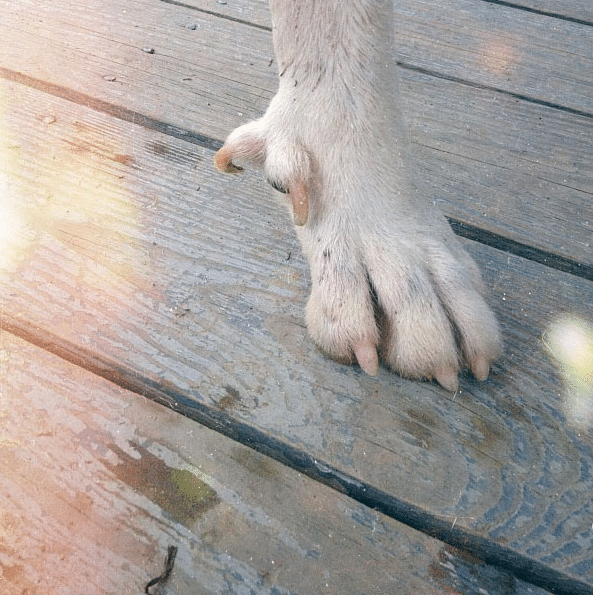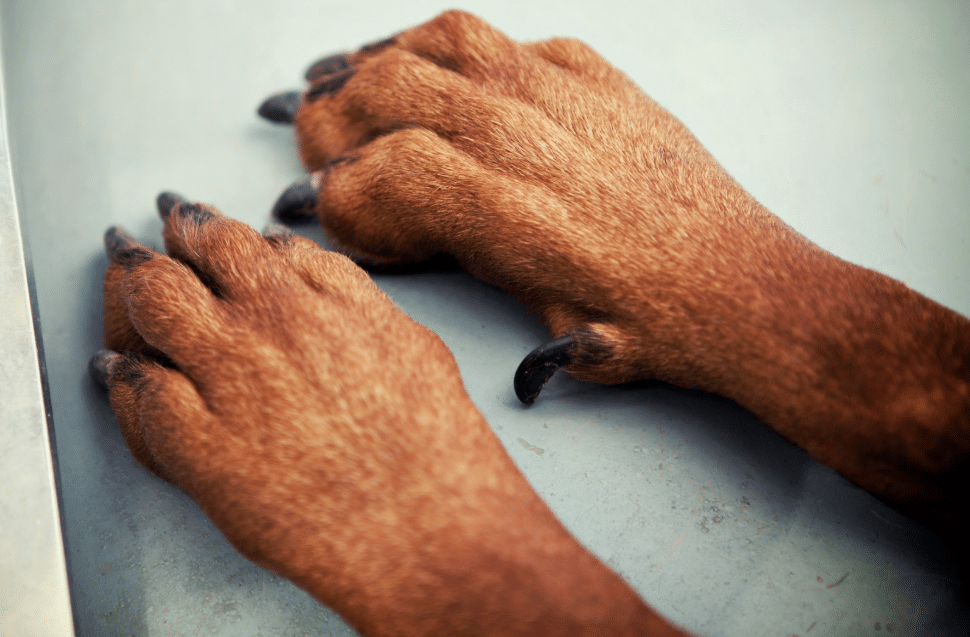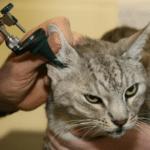Dew Claw Trimming
Dew Claw Trimming
Dew Claw: Psychology Today author Dr. Stanley Coren traces your dog’s dewclaw back 40 million years to “a tree-climbing cat-like animal known as miacis which was an early ancestor of our modern dogs,” he says.
“Obviously if you climb trees having five toes is an advantage. However, miacis eventually evolved into the ground-dwelling species cynodictus. From this point on, successive generations of the animals that would become our dogs began to become specialized as social hunters,”

Dogs almost always have dewclaws on the inside of the front legs and occasionally also on the hind legs. Unlike front dewclaws, rear dewclaws tend to have little bone or muscle structure in most breeds. It is normal, although not biologically necessary, that certain breeds will have more than one dewclaw on the same paw.
At least one of these dewclaws will be poorly connected to the leg, and in this case, it is often surgically removed.[citation needed] When a dog has extra dewclaws in addition to the usual one on each front leg, the dog is said to be double dewclaws.
- Front dewclaws: All dogs are born with a dewclaw on each front leg.
- Rear dewclaws: Some dogs are born with 1, 2, or even double dewclaws on the rear legs.
Rear dewclaws are considered an anomaly except in a few breeds where single or double well-developed rear dewclaws are parts of the breed, such as the Briard or Great Pyrenees. These should not be removed.
Dew Claw Removal
There is no valid medical reason for front dewclaw removal and even removal of well-developed rear dewclaws unless there’s a diseased dewclaw or dewclaw injury. Front dewclaws are a normal part of a dog’s anatomy. They are attached to the carpus by a separate metacarpal bone, forming an actual joint with the carpus.
In many breeds — but certainly, not all — the dewclaw has traditionally been removed in the first few days of a dog’s life. While in some breeds, the removal is thought to improve the appearance of the show ring. In others, it’s done to prevent possible injuries, such as being damaged while a hunting dog works through brambles. (Some breeders remove declaws themselves, but this is a task more appropriately handled by a veterinarian.)
Read Also: Long Haired Werewolf Cat
If dewclaws aren’t removed in the days after birth, the next opportunity is typically at the same time as a spay or neuter. If a puppy has torn or otherwise injured the dewclaws before that time, it’s certainly worth discussing their permanent removal to prevent reinjury.
Dew Claw Cat
Contrary to what many people believe about their cat’s claws, they do not retract completely inside a sheath or all the way into the paw. When a cat’s claws are in a resting position, they are up off the ground, resting in the fur around the toes. If you look closely at a cat with retracted nails, you can see the nail tips protruding from the fur. It’s a bit easier to see in the picture, here, of the sphynx cat that doesn’t have fur.
When a cat wants to use his claws, he contracts a tendon to extend them out and down. The extension and retraction of a cat’s claws are similar to the way in which a person points their toes and flexes their ankle back.
Dew Claw Removal Cost
Puppy dew claws will always be removed within days after the puppies were born, usually, when they are three to four days old, and the costs, from what we researched, will really depend on your vet, geographical location, and what may be included at the time during the dew claw removal as many vets will want to also include the vaccinations and perform an exam.
Read Also: Dew Claw Trimming
To make things simple, however, the costs to solely remove the dewclaws can range anywhere from $10 to $35 per puppy, but this usually won’t include the vet examination fee, which can be another $50 or so. Since most people bring in a litter of puppies, a lot of vets will include a discount after the first puppy, often as much as 10 to 30 percent off.

Motley Zoo was generous enough to cover the cost of the dewclaw removal, their bill included a Rescue Group Discount. The below is the cost were we to pay out of pocket.
- $39 Exam & Office Visit
- $85 General Anesthesia Induction
- $68 Inhalation Isoflurane
- $15 Surgical Pack Fee
- $12 Surgical Supply Fee
- $101 Dewclaw Removal Surgery
- $22 Polyflex Injectable (antibiotic)
- $39 IV Catheter
- $23 IV Fluid Therapy
- $22 Hospitalization
- $44 Bandage (really?)
- $20 Simplicef (prescription)
- $15 Rimadyl (prescription)
- $55 Laser Surgery Fee (we elected to pay extra for laser surgery)
Broken Dew Claw
- Favoring a paw by holding it in the air rather than walking on it
- Limping or visibly not putting weight on a paw while walking
- Blood on your dog’s bedding
- Constant licking of a paw
- A visibly swollen paw or toe
- Resistance when you try to examine a paw or toe
- Nail at an odd angle
The idea is to remove the remaining piece of the nail (the piece of nail that’s dangling) to prevent further injury and to allow for proper healing and regrowth of the nail. Removing the nail may cause your dog’s toe to bleed, especially if the breakage occurred at the quick of the nail.
Why Do You Remove The Dew Claws?
In many breeds — but certainly, not all — the dewclaw has traditionally been removed in the first few days of a dog’s life. While in some breeds, the removal is thought to improve the appearance of the show ring. In others, it’s done to prevent possible injuries, such as being damaged while a hunting dog works through brambles.
Which Dog Breeds Have Dew Claws?
- The Pyrenean mountain dog.
- The Beauceron.
- The Briard.
- The Norwegian Lundehund.
- The Anatolian shepherd dog.
- The Catalan sheepdog.
- The Saint Bernard.
- The Estrela mountain dog.
- Is Removing Dew Claws Cruel?
How Late Can You Remove Dew Claws?
The answer is yes, but first, one needs to differentiate between removing dewclaws and trimming dog nails. The dewclaw is actually a digit rather than just a claw, and the removal of dewclaws is thus far more complex and painful than simply trimming the dog’s nails, which does not cause the dog any pain at all.
How Late Can You Remove Dew Claws?
Typically, dewclaws are removed around 3-4 days of age. If the claws are not removed at this age, most experts suggest waiting until the dog is spayed/neutered to have them removed. Dewclaws can be removed in older dogs but it is a more costly and painful procedure.



